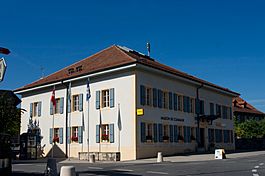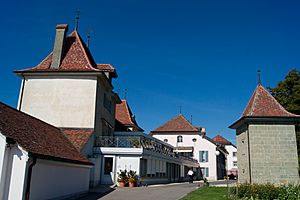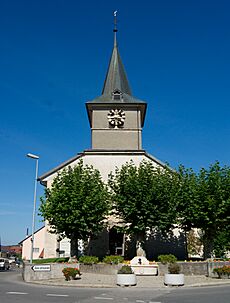Goumoens-la-Ville facts for kids
Quick facts for kids
Goumoens-la-Ville
|
||
|---|---|---|

Goumoens-la-Ville town hall
|
||
|
||
| Country | Switzerland | |
| Canton | Vaud | |
| District | Gros-de-Vaud | |
| Area | ||
| • Total | 7.27 km2 (2.81 sq mi) | |
| Elevation | 618 m (2,028 ft) | |
| Population | ||
| • Total | 650 | |
| • Density | 89.4/km2 (231.6/sq mi) | |
| Postal code |
1376
|
|
| Surrounded by | Échallens, Éclagnens, Goumoens-le-Jux, Penthéréaz, Saint-Barthélemy, Villars-le-Terroir | |
Goumoens-la-Ville was a small town, or municipality, located in the Gros-de-Vaud area of the canton of Vaud in Switzerland.
On July 1, 2011, Goumoens-la-Ville joined with two other towns, Éclagnens and Goumoens-le-Jux. They all merged to form a brand new municipality called Goumoëns.
Contents
History of Goumoens-la-Ville
Goumoens-la-Ville is quite old! The first time it was ever written about was in the year 1228. Back then, its name was spelled Guimuens li vila.
Geography of Goumoens-la-Ville
Goumoens-la-Ville covered an area of about 7.27 square kilometers (about 2.8 square miles). Most of this land, around 75%, was used for farming. This means people grew crops or raised animals there.
About 20% of the area was covered by forests. The remaining small part, about 5%, had buildings and roads. This shows that Goumoens-la-Ville was a very green and open place.
The town was part of the Échallens District until 2006. After that, it became part of the new Gros-de-Vaud district. It is located in the beautiful Gros-de-Vaud region of Switzerland.
Goumoens-la-Ville's Coat of Arms
Every town in Switzerland has a special symbol called a coat of arms. It's like a unique badge for the town. The coat of arms for Goumoens-la-Ville has a blue background. On it, there is a silver cross with special ends, and a green acorn in the middle of the cross.
People and Population in Goumoens-la-Ville
In 2009, Goumoens-la-Ville had a population of 650 people. A small part of the population, about 7.6%, were people from other countries. Over ten years, from 1999 to 2009, the town's population grew by about 7.3%.
Languages Spoken in Goumoens-la-Ville
Most people in Goumoens-la-Ville speak French. In 2000, about 96% of the people spoke French. A smaller number of people spoke German (about 1.6%) or English (about 0.7%).
Age Groups in Goumoens-la-Ville
In 2009, the population of Goumoens-la-Ville included:
- About 9% were children aged 0 to 9 years old.
- About 12.6% were teenagers aged 10 to 19 years old.
- About 11% were young adults aged 20 to 29 years old.
- About 13.4% were adults aged 30 to 39.
- About 14.6% were adults aged 40 to 49.
- About 15.7% were adults aged 50 to 59.
- About 9% were seniors aged 60 to 69.
- About 7.8% were seniors aged 70 to 79.
- About 5.4% were seniors aged 80 to 89.
- About 1.2% were very old seniors, 90 years and older.
Population Changes Over Time
The chart below shows how the population of Goumoens-la-Ville has changed over many years. You can see if the number of people living there went up or down.

Economy and Jobs in Goumoens-la-Ville
In 2010, the unemployment rate in Goumoens-la-Ville was low, at 2.4%. This means most people who wanted to work had a job.
People in Goumoens-la-Ville worked in different types of jobs:
- Primary Sector: These jobs involve getting raw materials from nature. In 2008, about 35 people worked in this sector, mostly in farming.
- Secondary Sector: These jobs involve making things. About 54 people worked here, mainly in manufacturing (making goods) and construction (building things).
- Tertiary Sector: These jobs involve providing services. About 123 people worked in this sector. This included jobs in sales, transportation, finance, education, and healthcare.
Many people who lived in Goumoens-la-Ville traveled to other towns for work. In 2000, about 228 people left the town for their jobs, while only 86 came into the town to work. Most people (about 65.5%) used a private car to get to work. A smaller number (about 8.7%) used public transportation.
Religion in Goumoens-la-Ville
According to a survey in 2000, most people in Goumoens-la-Ville were Christian.
- About 70% belonged to the Swiss Reformed Church.
- About 19.6% were Roman Catholic.
- A small number of people belonged to other Christian churches.
- About 9.5% of the population did not belong to any church, meaning they were agnostic or atheist.
Education in Goumoens-la-Ville
Education is important in Goumoens-la-Ville. In 2000, about 42.4% of the adults had finished high school (upper secondary education). Also, about 13.4% had gone on to higher education, like a university or a specialized college.
In the 2009/2010 school year, there were 68 students in the local school district.
- Children could attend two years of non-required pre-school.
- The main primary school program lasted for four years. There were 33 students in primary school.
- After primary school, students went to lower secondary school for six years. There were 34 students in these schools.
- A few students were also homeschooled or attended other types of schools.
In 2000, some students from Goumoens-la-Ville went to schools in other towns. Also, some students from other towns came to school in Goumoens-la-Ville.






